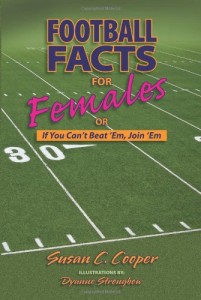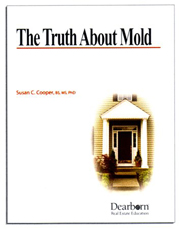Author and artist Susan C. Cooper worked as an environmental engineer for 17 years after earning a BS in biology, MS degrees in physiology and geological engineering, and a Ph.D. in physiology and biochemistry. Born and raised in Milwaukee, she now makes her home in Albuquerque. Her first book, The Truth About Mold, is in its third edition. Football Facts for Females, published in 2014, is her second book. You can find Susan on Facebook and her website FootballFactsForFemales.com.
 What is your elevator pitch for Football Facts for Females or If You Can’t Beat ‘Em, Join ‘Em?
What is your elevator pitch for Football Facts for Females or If You Can’t Beat ‘Em, Join ‘Em?
Starting with the basics and merging into more complex details such as strategy, this book combines information about football with humor to make it fun to read. It also includes a chapter about the importance of choosing a favorite team and players and how to do that.
What inspired you to write it?
I wanted to improve my relationship with my husband Randy, a relationship that was really quite good—except for football season. Many years ago, Randy was willing to learn about classical music for me; why couldn’t I do the same thing for him with respect to football?
What unique challenges did this work pose for you?
I started writing the book nearly 20 years ago, when there was no Internet, only newspapers, magazines, and books—and all of which were written without humor and assumed the reader already spoke footballese.
I found an agent, who took all the humor out of the book (except for the glossary), and he found a publisher. But when Football for Dummies was published, my publisher lost interest. I shelved the manuscript temporarily, but it was always at the back of my mind. Then Randy and I went to Craig Duswalt’s RockStar Marketing Bootcamp—which has its own publishing house. I started working on the manuscript again, revising and updating it. My last hurdle was my own fault caused by my perfectionism. I didn’t want to send the manuscript in to be published until it was perfect. One of my new friends from the bootcamp pushed me to go ahead and publish it. I did.
One of the endorsements on the back cover is from football legend Joe Theisman. How did that come about?
Craig Duswalt is distantly related to Joe. He suggested it. So I sent Craig a copy of the manuscript, and he sent it to Joe. I also have a testimonial from sports newscaster Jim Nantz who wrote, “Super job, Susan! Kudos!” That came about because an elderly man at my church bought a copy for his daughter—and fell in love with it. He bought another copy to send to Jim Nantz with whom he sometimes corresponds. (I received this testimonial after the book had already been published, so it doesn’t appear in the book itself.)
I have received a couple of other testimonials that are important to me. One was from one of my reviewers who worked at the House of Football. Levi Doporto has played the game, coached it, and refereed games. He was amazed that a woman could write a book about football—and not sound like a woman. He learned a number of new facts about football, and every time he questioned something I wrote, he looked it up and found I was right. (How cool is that?!) The other important testimonial was from James Malinchak, a motivational speaker known as the “big-money speaker.” He’s friends with Joe Theismann and was also impressed with Football Facts for Females. He told me how much Joe loves the book.
What inspired you to become a writer?
I’m afraid I’m not the typical writer who just has to write or she will die. But I’ve been writing (and editing) for many years—grant proposals, a chapter of a book on rickettsial diseases as a ghost writer, translations of several scientific papers, two theses and a dissertation, articles for publication, reports and other documents as an environmental engineer, etc. Later, I wrote articles about restaurants for PrimeTime and articles about art and photography for The Pastel Journal. When I worked for the board of REALTORS in Albuquerque, I wrote two articles every week for the local real estate magazine, helped develop a course on mold, and wrote the first edition of my book about mold (The Truth about Mold), along with an online course for continuing education for REALTORS®. Writing was just something I did.
You’ve been a member of Toastmasters for about 30 years. How has participating in that organization helped you in your writing and publishing journey?
Toastmasters has helped me develop confidence and given me a better insight into using humor effectively (which I couldn’t use in any of the three editions of my mold book, but I certainly did use in my football book).
Who are your favorite authors and what do you admire most about their writing?
Janet Evanovich for her humor. James Patterson—I love any author who writes well enough to keep me from putting the book down. I love his short chapters and his ability to keep me reading because of the tension he puts into his chapters. And his productivity? Holy cow! Even though he has so many co-authors working with him, his novels are all consistent with those characteristics and interesting plots. And they’re never boring, even though he obviously uses a pattern for his novels.
Why did you decide to take the indie route to publication?
Opportunity led me to publish The Truth about Mold with Dearborn/Kaplan, a standard publisher that focuses primarily on books dealing with real estate and finances. For my book about football, I tried the whole mess of looking for an agent nearly 20 years ago, and I just didn’t have the energy to do that again. Football Facts was actually published by RockStar Publishing House, a kind of hybrid of indie and traditional publishing. They have everything available in house—you just have to decide what you want done, and then pay for it. It turned out to be an expensive proposition because the book was longer than what they usually publish, and has a lot of illustrations, an index, and a glossary. I am pleased with the overall product, but I’m looking forward to publishing at least one book via CreateSpace and not having to pay an arm and a leg for it.
 And now to The Truth About Mold, your 2013 book full of important facts about…mold. There’s a running joke at many SWW meetings where many writers (especially Jon Miller) make reference to mold when they’re plugging their own books. Many visitors to SWW meetings probably don’t understand the reference. Would you like to explain?
And now to The Truth About Mold, your 2013 book full of important facts about…mold. There’s a running joke at many SWW meetings where many writers (especially Jon Miller) make reference to mold when they’re plugging their own books. Many visitors to SWW meetings probably don’t understand the reference. Would you like to explain?
Somehow, I am able to make mold funny, even though mold really isn’t funny but can be a serious problem. I’ve done that enough at SWW meetings that a number of our members (like Jon) have picked up on it and embellish it. And I absolutely love that feedback, which they all seem to know and appreciate!
So far you have published only nonfiction books. Do you have plans for fiction projects? What are you working on now?
Randy and I are working together on a novel titled Moment of Death based on an idea he had years ago. Randy has been a sculptor for about 20 years. The main character in Moment of Death is—big surprise—a sculptor! One of his clients dies because of a freakish set of circumstances, teaching him a valuable lesson to use in his sculpting. We’ve been working on this novel for a long time and are hoping to finish it this year. I also want to write a book about mold for the public—one with humor in it but covering some important information that is often not talked about. After taking one of Betsy James’ courses, I discovered the snark in myself and that writing fiction is even more fun than writing nonfiction. Last year I wrote a science fiction novel. It’s something I still want to get back to and publish. I have also written other stories I’d like to develop; there are a couple of them I think have a lot of potential.
What advice do you have for writers still striving for publication?
“Don’t wait until it’s perfect, because it’ll never happen.” Obviously, it’s necessary to do a thorough job editing, but it’s too easy to get hung up on minor things and never get the job done, especially for someone anal with perfectionist tendencies, like me.
Also, beware of critique groups and how you deal with them. Yes, they can give you invaluable insights into your book, but remember it’s YOUR book and your ideas, not theirs. You have to make the decision as to what you want to say instead of allowing yourself to be led astray by the ideas of other members of your group.
And if you’re a writer who gets discouraged, like I do, I find it helps to read. I have books I’m reading on each of my two Kindles, my cell phone, my iPad, and my Galaxy tablet. (And I always have at least one “real” book going.) I’ve read good books and really bad ones through my Bookbub subscription, but even the bad ones are useful—”this is what a writer shouldn’t do, and here’s a good example of why.” Or “here’s something that works really well. Great idea.”
 KL Wagoner (writing as Cate Macabe) is the author of This New Mountain: a memoir of AJ Jackson, private investigator, repossessor, and grandmother. She has a new speculative fiction blog at klwagoner.com and writes about memoir at ThisNewMountain.com.
KL Wagoner (writing as Cate Macabe) is the author of This New Mountain: a memoir of AJ Jackson, private investigator, repossessor, and grandmother. She has a new speculative fiction blog at klwagoner.com and writes about memoir at ThisNewMountain.com.


Leave a Reply